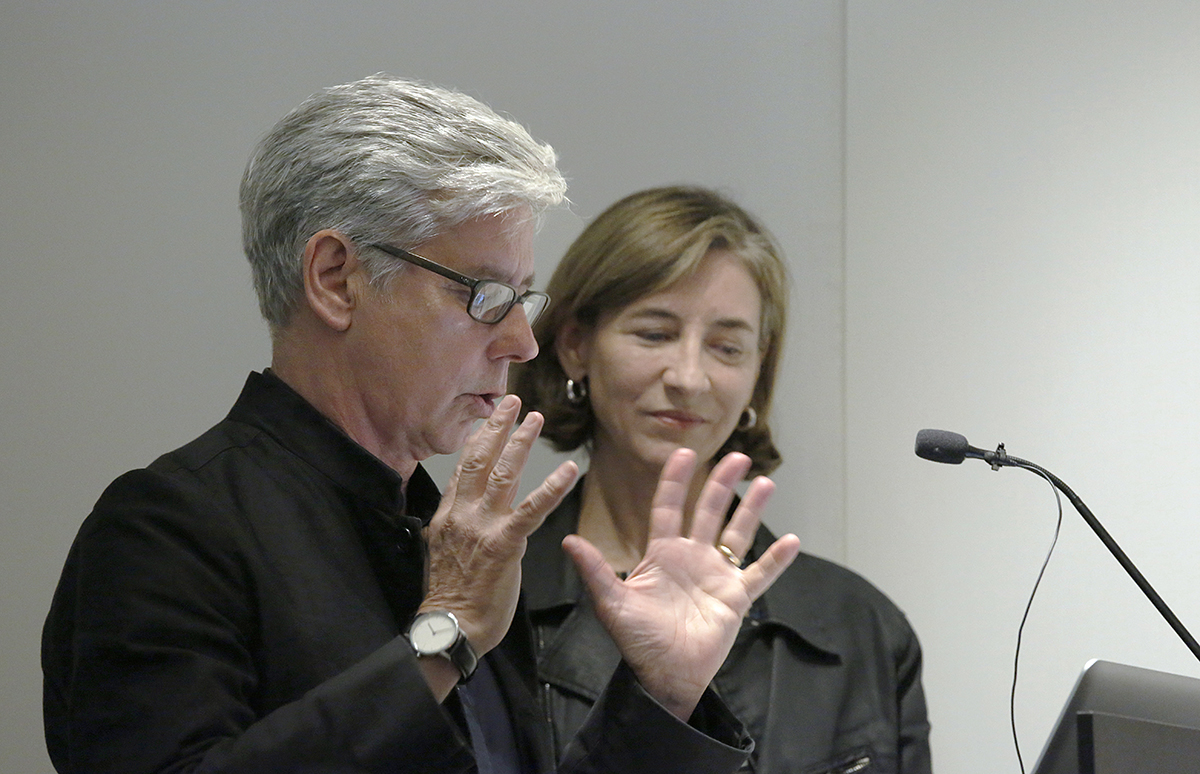The Bridge architects talk design, academe and industry
By Patti Witten

Marion Weiss and Michael A. Manfredi, M.Arch. ’80, co-founders of the Weiss/Manfredi architecture and landscape design firm, gave an inside look at their design process for The Bridge at Cornell Tech. They delivered the annual L. Michael Goldsmith Lecture April 19 at the College of Architecture, Art and Planning facility in Manhattan.
Kent Kleinman, the Gale and Ira Drukier Dean of AAP, said: “Few architects working today embody an expanded conception of architecture as do Weiss and Manfredi. Part earth art, part engineering marvel, part urban theater and part site archaeology, their projects perform on so many levels that any single disciplinary lens is inadequate to encompass them.”
The architects’ interest in an expanded territory for architecture free of disciplinary boundaries is exemplified in The Bridge, a focal point of the Cornell Tech campus, which opens in September, part of Cornell’s expanding presence in New York City. The Bridge is a corporate co-location building that will bring new technologies to market faster by housing established tech companies and startups side by side with academic researchers.
“We loved Cornell’s proposition to take the 100 square miles of Silicon Valley and compress them on an island – there is something incredibly provocative about that as the idea of a campus,” said Manfredi. “It’s a rare opportunity to invent an academy, and Cornell has been extraordinarily bold.”
Weiss called the project an unprecedented kind of invention as well as a “bridge” between the academy and industry.
“The co-clients and the co-location gave the idea of convergence even more relevance and a whole new set of opportunities,” said Weiss. “This dialogue is in a sense an invention, with all parties believing in something that has never been there before now.”
Pointing to renderings and photos of interiors under construction, the architects detailed the building’s central “bowtie” configuration that draws together all its occupants, who all have access to light, to see and be seen within a flexible, loft-like layout.
“The fantasy of this building for Cornell is that everything that happened in Silicon Valley – inefficiently and distributed geographically – could happen right here,” said Weiss. “What would require long drives in California could turn into short walks up a staircase.”
The architects demonstrated how the lift and lofting of the bowtie’s cantilevered wings and the site “cracked open like a wedge,” offer views from river to river and peeks between the other campus buildings. Inside, sight lines are maximized by slim trusses and minimizing columns.
During a Q&A, one of the several Goldsmith family members in attendance asked about the comfort and efficiency of the glass surrounding the building. Weiss and Manfredi explained how a “prismatic magic” was accomplished with high performance, UV-coated glass and a visual trick: shadow boxes behind the glass wherever there is a floor plate.
Asked how students should approach comprehensive design, the architects said Cornell AAP NYC is already doing what they would recommend by bringing in consultants, “thought leaders” who are forging the future of their disciplines. The architects urged the students to see the obligations of each discipline as opportunities.
For Manfredi, finding new ways to merge finite resources with existing topography and previously built structures is an ethical agenda. “We’ve always been drawn to public projects, to architecture’s redeeming capacity to reach a larger audience,” he said.
“The setting is magical,” said Manfredi. “The chance to rethink the pedagogy of the academy and the agendas of entrepreneurship will start to play out over the next five to 10 years on this very spot.”
The Goldsmith lecture was established in memory of L. Michael Goldsmith by his family and friends in recognition of his passion for his education at Cornell, his career, and love of the profession of architecture.
Patti Witten is a writer for the College of Architecture, Art and Planning.
Media Contact
Get Cornell news delivered right to your inbox.
Subscribe